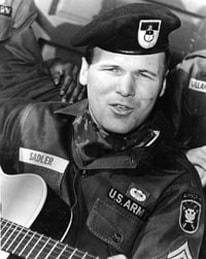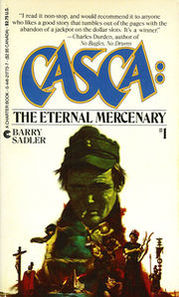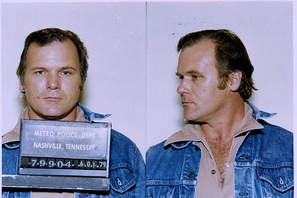 by Julian Spivey One of the most famous and popular patriotic songs of all-time is “The Ballad of the Green Berets,” which was co-written (along with author Robin Moore) and performed by an actual Green Beret medic Staff Sgt. Barry Sadler. The ballad would become the biggest hit of 1966 topping the Billboard Top 40 chart for five weeks and achieving crossover status on the pop and country charts. Sadler’s life would certainly prove to be a whirlwind going from national hero to being involved in two mysterious shootings in his short life. Most know about his hit song, but few seem to remember or know about what happened to him after the fame had faded. Sadler had served in the Vietnam War for five months from late December 1964 until late May 1965. In May of ’65 while on combat patrol in the central Vietnam city of Pleiku he was severely wounded in the knee when he stepped on a punji stick – a booby trap stake. Sadler was able to dress the wound and complete his patrol but developed a serious infection of the leg and had to be evacuated to the Clark Air Force Base Hospital in the Philippines. He would soon be returned to Fort Bragg in the United States where he would make a complete recovery. By the end of the year he would have written and recorded “The Ballad of the Green Berets.” The song was released in early 1966 by RCA Victor Records and was No. 1 for five consecutive weeks from March 5 through April 2, selling more than nine million copies. The song was included on the album Ballads of the Green Berets, featuring more patriotic military anthems. Sadler would see a second minor hit “The A-Team” before the end of the year. During his televised performances Sadler would wear his military uniform featuring many of the honors or awards he won for his service, among them being the Purple Heart, Army Good Conduct Medal, Combat Infantryman Badge and Parachutist Badge. Despite his meteoric rise as a balladeer in 1966 his music career would essentially be over by year’s end. In fact, he would never record another album of material.  In the late ‘70s, after more than a decade outside of the public eye, Sadler had settled down in Nashville and began a literary career with the Casca series of paperback novels based on a fictional mercenary figure named Casca Rufio Longinus, a soldier in the Roman legion who drove the Holy Lance into the side of Jesus Christ and thus has been cursed to wander the Earth as a soldier aimlessly until Christ’s Second Coming. Sadler would write 22 novels in the series before his death, with the first being published in 1979. Sadler’s literary agent Robbie Robison would tell the Los Angeles Times: “The way he describes things, he could make it rain on the page. And he could make it rain blood. No one write slaughter like Sadler.” The same year he would see literary success he would also undergo legal troubles after a mysterious death of a washed-up country music singer named Lee Emerson. Emerson had always been a struggling country singer all the way back as far as the 1950s when he recorded for Columbia Records without ever charting any hits. He did, however, write a few hits for other country singers like Marty Robbins’ No. 1 “Ruby Ann” in 1963. His most success would probably be as Robbins’ manager. By all accounts, Emerson was a mean son of a bitch, who didn’t shy away from a fight and had an addiction to pills. In 1968, Emerson shot and wounded a man in Memphis, Tenn. He fled from police to Florida but was eventually caught and sentenced to a three-year stint in prison. After that prison sentence he would wind up back in the Country Music Capital of the World, Nashville. Emerson would shack up with a girlfriend named Darlene Sharpe and it wouldn’t be long before the relationship turned abusive. Sharpe said in Michael Streissguth’s excellent book Outlaw: Waylon, Willie, Kris and The Renegades of Nashville, “No one realized that Lee was really doing these things to me until he broke into my apartment and told me and my sister that he was going to kill me. I picked up the telephone to call the police and he jerked that cord out of the wall.” Emerson would later bust one of Sharpe’s leg muscles with a piece of firewood and threatened to poke one of her eyes out, leaving her completely blind, as she had previously lost one in a car accident. Eventually Sharpe and Emerson would part ways, but Emerson would leave some of his lyrics behind in her place. Sharpe’s next boyfriend would be Staff Sgt. Barry Sadler. One night on the streets of Nashville Emerson would spot Sharpe and Sadler out on the town and went to demand the return of his lyrics. Sadler stepped in to defend Sharpe and the two tussled, with Emerson’s son Rodney claiming that “Dad flattened him. There was that left hand out of nowhere that could do it and he done it.” Emerson would begin harassing Sadler and Sharpe any chance he could, reportedly running Sharpe off the road and jeering the proud Green Beret Sadler about how “sissy Green Berets” were.  On Dec. 1, 1978 shortly before midnight, Emerson appeared in a parking lot outside of Sharpe’s apartment. There’re some discrepancies as to why he was there. Sadler recounted that Emerson had phoned in threats earlier in the night and showed up to make good on them, whereas Emerson’s son, Rodney, claimed that his father had been lured there. However, the reason for Emerson appearing near Sharpe’s apartment, we know that he would soon be dead at the hand of Sadler. While Emerson sat in his van in the parking lot, Sadler emerged with his .32-caliber pistol and shot him in between the eyes. Sadler, according to Streissguth’s book, then planted a different gun in front of Emerson’s body and phoned the police to claim he just shot a man in self-defense. Sadler would end up telling a reporter: “I fired to miss him by two feet and I’m a damn good shot. If I’d been trying to kill him, I could have put a bullet in his ear. But I shot to miss, and I’ve never heard of a bullet making a 90-degree turn.” It didn’t take long for detectives to determine that the gun found in Emerson’s vehicle was registered in Sadler’s name, nor did they find evidence of Emerson firing a weapon. Sadler hired hot-shot Nashville attorney Joe Binkley. The district attorney’s office charged Sadler with second-degree murder, but less than a year later he would plead guilty to voluntary manslaughter and received a four-to-five year prison term. Shockingly, a judge reduced the sentence four months after it was imposed to just 30 days and due to good behavior Sadler only even served 28 of those days. According to Streissguth’s book the files from the case are missing from the criminal court archives today. It seemingly pays to be a famous national hero. Five years after potentially getting away with second-degree murder Sadler would move to Guatemala City, the capital city of the Central American country. He would continue to write and publish books in the Casca series, but four years after moving to Guatemala would be involved in another mysterious shooting, this time of himself. On Sept. 7, 1988, while sitting in a taxi cab in Guatemala City, Sadler was shot in the head. Witnesses told authorities that Sadler had accidentally shot himself, but friends and family believe that Sadler had either been shot by an attempted assassin or in a robbery gone wrong. In a 1989 article in the Los Angeles Times entitled ‘The Ballad of Barry Sadler’ written by Bob Sipchen a medical authority who asked not to be named said the wound was “inconsistent with the handgun story.” According to Sadler’s friend Duke Faglier in that same article there were no powder burns, which there should have been if Sadler was accidentally shot by himself at close range. Perhaps it was karma or the ghost of Lee Emerson? Sadler was flown back to the U.S. on a private jet paid for by Bob Brown, publisher of Soldier of Fortune magazine and underwent life-saving surgery at the Nashville Veterans Administration Hospital. Sadler remained in a coma for six weeks and when he regained consciousness, he was a paraplegic and had suffered serious brain damage. Sadler would die of cardiac arrest just over a year after the shooting on November 5, 1989. He had just turned 49 four days before. He was survived by a wife, a daughter and two sons.
5 Comments
11/14/2018 06:12:30 am
Wish you had mentioned my book, Ballad of the Green Beret, the first and only biography of Barry Sadler.. And sorry you didn't credit me or my website for that mug shot, which I acquired from the Nashville PD. Also: he didn't step on a punji stick, he took one in the knee. And it wasn't in the "city of Pleiku." It was out in the boonies far from Pleiku.
Reply
Julian Spivey
11/14/2018 12:29:28 pm
Sir, I never mentioned your book, which I have not read. I mentioned a book by Michael Streissguth and an LA Times article, both of which I credited.
Reply
Brian wood
10/11/2021 05:20:00 am
I love Barry’s song “Green Beret”
Reply
Capt Joel Brandwein
2/5/2023 08:57:42 am
For more than 50 years, I still get goosebumps every time I hear that song. Sergeant Sandler I know you have wings.
Reply
9/26/2023 07:02:20 pm
Think I understand Sadler's song "Green Beret" better than most cause me was also a Staff Sergeant in the Bushwar of South Afrika fight in Southwest Africa today Namibia from 1966 - 1989.The song Green Beret was even a hit song in (my) our Army days then, and till today our old Veterans like to sing it ourself or like to hear it at a braai. Ollie Joubert (SWA) Namibia 13500- Semper fi
Reply
Leave a Reply. |
Archives
July 2024
|